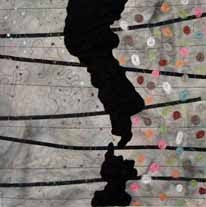One of the highlights of the quilts exhibition at the V&A, for both the curators and me was the George III coverlet, but for different reasons. The coverlet, of which I only have details of the centre, is surrounded by forty appliquéd scenes of life from the early 19th century. These have been carefully researched and excited the historians and curators as they have traced the sources of the scenes back to prints available at the time and many of them show then current events. These historical scenes are interspersed with images of domestic life, giving an insight into the maker’s home life. They are very detailed.

However interesting these are, what excited us as quilters were the circular patterns covering the centre of the coverlet, which is why I have no images of the borders! There would have been 324 of them, but some have been covered by the medallion of ‘George III reviewing the troops’. This appliquéd medallion raised a lot of questions. Why would anyone spend all that time piecing all the circles to then cut away to put the medallion in? Also, it is referred to as the ‘central’ medallion, but it isn’t in the centre – it is nearer the top than the bottom. I suppose this could be as the coverlet was intended for use on the bed, so it would be on the centre of the bed. However, I’m not sure what the purpose of the coverlet was. Is it for a bed?
Another question that wasn’t really discussed in the catalogue, is not only has the ‘central’ medallion been appliquéd over the circles, there are two sun circles, bigger than the other circles over them, in no discernable pattern and the central medallion cuts through one of them. How could a maker of such skill do this? What was the intention? Did it change?
The remaining circles from the 324 which haven’t been appliquéd over (and I assume the circles underneath have been cut away to keep the fabric the same weight over the whole coverlet, so the evidence of them has disappeared), are an amazing variety of patterns and designs in circles. Katy, the web editor of Popular Patchwork, suggested that the circles would make a fantastic quilt in the style of the famous ‘Dear Jane’ one, copying all these patterns faithfully. I’m sure I’m not the person to do this, but the patterns are inspiring. I’ve already started doodling circles and then trying to divide them in interesting ways.
Normally I don’t get as excited by historical work as contemporary, but this quilt is fascinating, as are all the questions it raises for quilters. Have a look at the circles and see what you think of them.
(Images courtsey of V&A or taken with their permission as per the previous post)

























